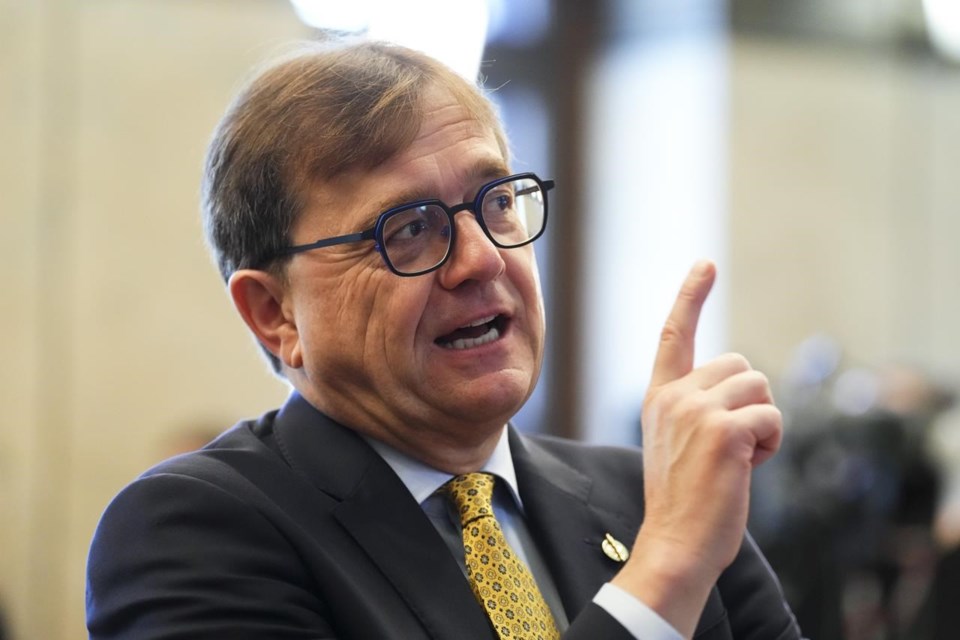OTTAWA ŌĆö The federal government is to tie billions of dollars in tax credits and grants for provincial electricity projects to progress toward Ottawa's target for an emissions-free electricity grid by 2035.
"To access the tax credit will require that we are moving in the direction of a non-emitting grid," Energy and Natural Resources Minister Jonathan Wilkinson said Tuesday.
"We are in the process of consulting broadly, including with the provinces and territories, about how we will implement that in terms of the conditionality of the tax credit."
The federal budget already made clear the restriction would be in place for the new refundable 15 per cent clean electricity investment tax credit, which is for investments in non-emitting electricity production, storage and interprovincial transmission.
But there are several other new investment tax credits for hydrogen production, clean technology and carbon capture and storage systems, worth tens of billions over the next 12 years. There is also at least $3 billion in grants for renewable electricity projects and technology upgrades to make the grid more efficient, and the federal government has promised to consider helping fund transmission lines inside provinces in certain situations.
Wilkinson made the announcement in Vancouver, where he acknowledged that net-zero grids will look different in different parts of the country.
"Provinces and territories have different starting points," he said. "There will necessarily be different pathways."
Wilkinson said more details on how that flexibility would be achieved will come with the regulations.
"We are cognizant of the need for regulations to provide sufficient flexibility. There needs to some allowance for backup, there needs to be some allowance for emergencies. We have to be thoughtful about stranded assets."
Minister of Environment and Climate Change Steven Guilbeault is expected to publish the first draft of those rules as early as this week. They will spell out, for example, a timeline for natural gas power plants to be closed or fitted with carbon-capturing systems.
Committing to a net-zero electricity grid is an easy move for six of the provinces, which are already more than 90 per cent of the way there. They have to make a lot more power but they don't have to replace most of the power they already produce.
For the other four ŌĆö Alberta, Saskatchewan, Nova Scotia and New Brunswick ŌĆö coal and natural gas still supply between 30 per cent and 85 per cent of their power. That makes a clean grid by 2035 a much steeper challenge ŌĆö so much so that Alberta and Saskatchewan have simply said they can't do it.
"We will not attempt the impossible when it comes to power production in our province," Saskatchewan Premier Scott Moe said in May.
"We will not risk plunging our homes, our schools, our hospitals, our special care homes, our businesses into the cold and darkness because of the ideological whims of others."
Both provinces have said they are instead targeting a non-emitting grid by 2050. That's the year sa╣·╝╩┤½├Į is also aiming to be net-zero emissions, which means any greenhouse gas emissions that are still produced are captured by nature or technology.
Aiming for net-zero electricity earlier is key because it unlocks the potential to decarbonize many other industries down the road. Electric vehicles, for example, are only non-emitting if the power used to charge their batteries comes from non-emitting sources.
Wilkinson told The Canadian Press in an interview that he's not trying to draw a line in the sand but there has to be some connection between the billions of dollars on offer and progress toward sa╣·╝╩┤½├Į's goals.
"You know, my style is not to have big fights," he said. "I actually like to listen to what people and provinces have to say and to try to figure out a pathway through which we can accomplish the goals that we all want to achieve."
He also said the disagreement isn't about whether to build non-emitting electricity. It's about how fast to do it.
"The gap that exists between us is not about whether we should have a non-emitting grid. It's about whether we get there by 2035 or somewhere a little bit later," he said.
Wilkinson commended Alberta for ┬Ādoing what he said was the most of any province to expand its solar power production. The province is also well ahead of schedule on retiring or converting its coal-fired electricity generators, he noted. The last one will be converted before the end of this year.
Premier Danielle Smith, however, announced last week the province was pausing approvals of new large wind and solar power projects for six months while it addresses concerns about the effect on farmland, scenery, reliability and eventually, cleaning up the projects at the end of their life.
Wilkinson said he is taking Alberta "at its word" that the pause is just to ensure everything is being done properly in the face of faster-than-expected growth, particularly in solar power.
He also said he thinks there is already a good conversation happening with Alberta, and he is convinced an agreement between the two governments is possible.
This report by The Canadian Press was first published Aug. 8, 2023.
Mia Rabson, The Canadian Press



